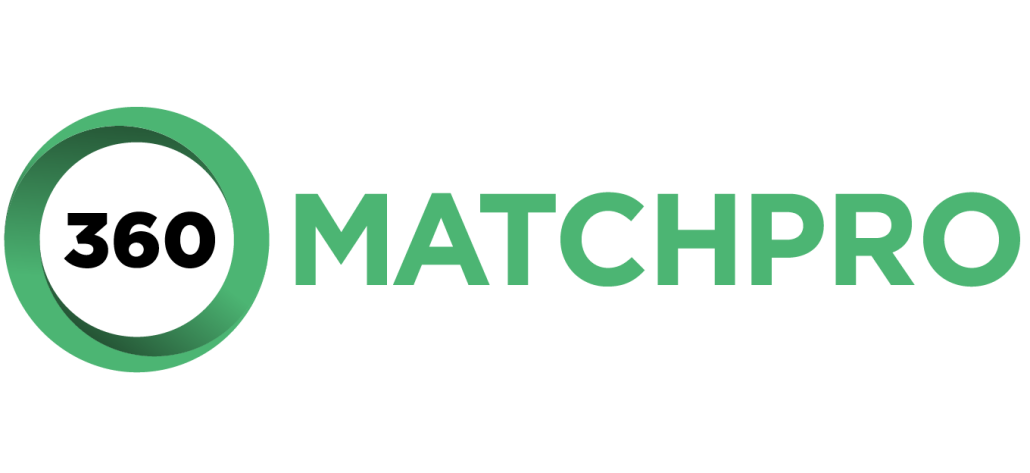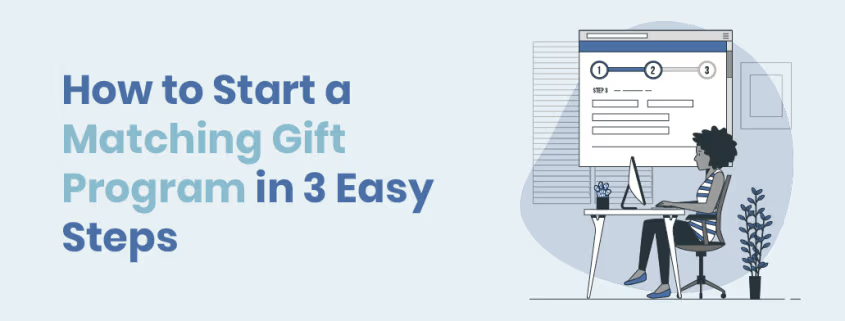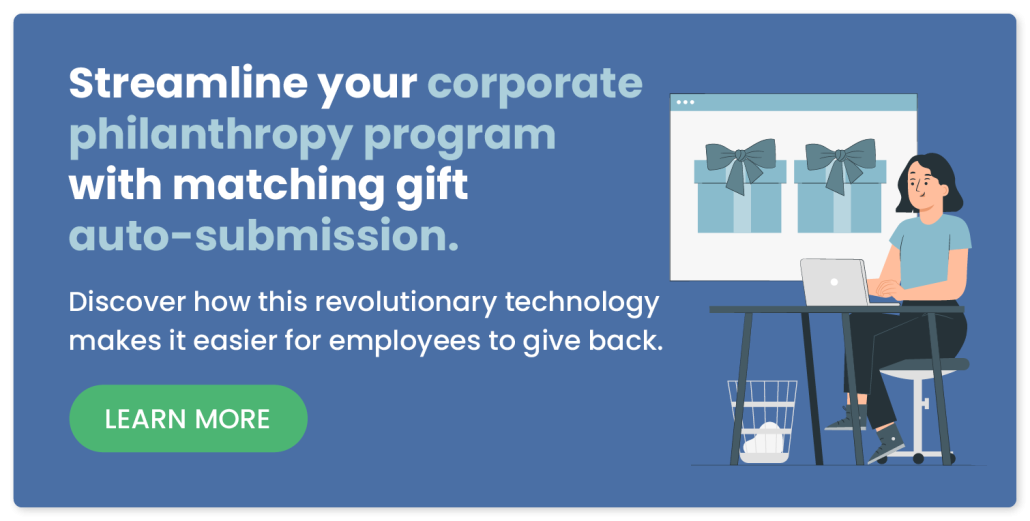How to Start a Matching Gift Program in 3 Easy Steps
In an era where corporate social responsibility has become a cornerstone of successful business practices, organizations are looking for new ways to give back to the communities they serve. One powerful way to do this is to establish a matching gift program.
A matching gift program allows your business to financially match employee donations to charitable organizations. By doubling the impact of your employees’ contributions, you not only encourage their philanthropic spirit but also amplify the positive change your company can make in the world.
In this guide, we’ll explain how to start a matching gift program. Whether you’re a small startup or a large corporation, these insights will help you establish a successful program that aligns with your company’s values and aspirations.
The Benefits of Starting a Matching Gift Program
As you consider whether to start a matching gift program at your business, you may wonder what tangible benefits it will bring. Fortunately, there are numerous advantages to consider, all of which can positively impact both your organization and the causes it supports.
Here are some compelling reasons to embark on this philanthropic journey:
- Improved reputation: Matching gift programs showcase companies’ commitment to social responsibility and community engagement. By supporting employee donations and doubling their impact, your business can build a positive brand image, attract socially conscious customers, and strengthen relationships with stakeholders.
- Increased employee engagement: When you demonstrate a commitment to philanthropy and provide opportunities for employees to make a difference, it fosters engagement among staff members. Employees are more likely to feel connected to the company’s mission, leading to increased loyalty, productivity, and retention. Plus, by directly matching employees’ donations, you’ll show that you care about the same causes they do and want to work together to make a difference.
- Expanded philanthropic impact: Matching employee contributions allows your business to double or even triple many individual contributions to charitable organizations. With increased financial support, nonprofits can expand their programs, reach more beneficiaries, and make a greater difference in the communities they serve.
Overall, matching gift programs are a win-win-win scenario for your business, your employees, and the nonprofits you support.
How to Start a Successful Matching Gift Program
If you’re ready to start a matching gift program at your business, follow these three steps for success.
1. Establish Matching Gift Guidelines
Matching gift guidelines are a set of predetermined rules and criteria that your business will use to govern its matching gift program and ensure consistency, transparency, and fairness.
To create these guidelines, you’ll need to do four things:
Identify minimum and maximum donation amounts.
Most companies that start matching gift programs also enact annual thresholds for their employees who participate. After all, you don’t have an unlimited budget to match donations, so you’ll need to determine amounts that your company is willing and able to match per employee.
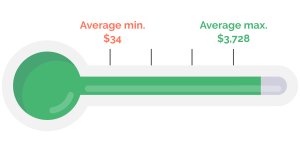
Setting minimum amounts ensures that employers are matching donations to organizations their employees truly care about. At the same time, maximum limits guarantee that there’s enough of the program budget to go around so that anyone who wants to get involved can!
To help you get a feel for what other corporations are offering, 93% of companies have a minimum match requirement of less than or equal to $50, with the average minimum falling at $34. On the flip side, 80% of companies’ maximums are set between $500 and $10,000 annually per employee, and the average maximum match amount is $3,728 (source).
Keep in mind that research indicates higher matching gift caps tend to yield elevated employee engagement levels. For example, maximums set at $1,000 see a 12% employee engagement rate. Meanwhile, limits between $1,001 and $10,000 see 18% engagement, and caps beyond $10,000 see a spike in employee engagement up to 40%. Assess your available resources to set a maximum that prompts high matching gift rates without breaking your budget.
Decide on a matching gift ratio.
A matching gift ratio is the rate at which a company agrees to match its employees’ charitable donations. It essentially determines how much the business will contribute to its team members’ favorite causes.
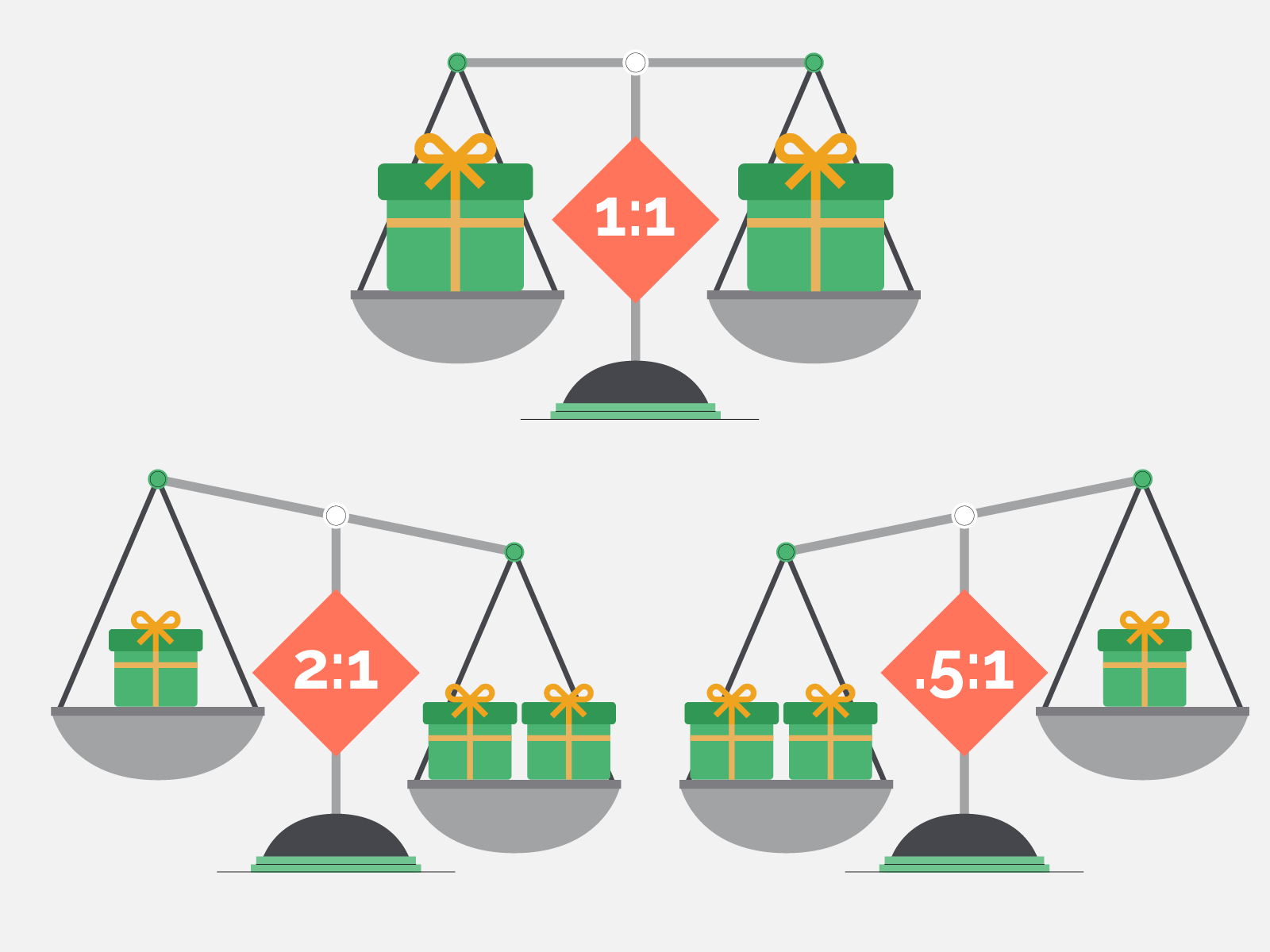
When it comes to corporate match ratios, an analysis of top matching gift companies reveals the following:
- 91% of participating companies match employee donations at a 1:1 ratio (i.e., a $100 initial donation results in a matching $100 corporate contribution for a total value of $200).
- 4% match at a lower rate (such as .5:1 or .75:1), meaning an initial $100 donation results in a $50 or $75 corporate match.
- 5% match at a higher rate (such as 2:1 or 3:1). In this case, a $100 donation may produce a $200 or $300 corporate gift match, tripling or even quadrupling its initial impact.
Again, higher match rates produce elevated participation levels among corporate employees, so consider this point as you develop your program. One option may be to set a basic matching gift ratio that is then increased at certain times throughout the year—such as on GivingTuesday or during affinity months.
Determine qualifying nonprofits and employees.
Companies generally establish specific criteria regarding the kinds of nonprofits they’ll contribute to—and the employees whose donations they’ll match.
Regarding eligible nonprofits, guidelines typically include some combination of the following:
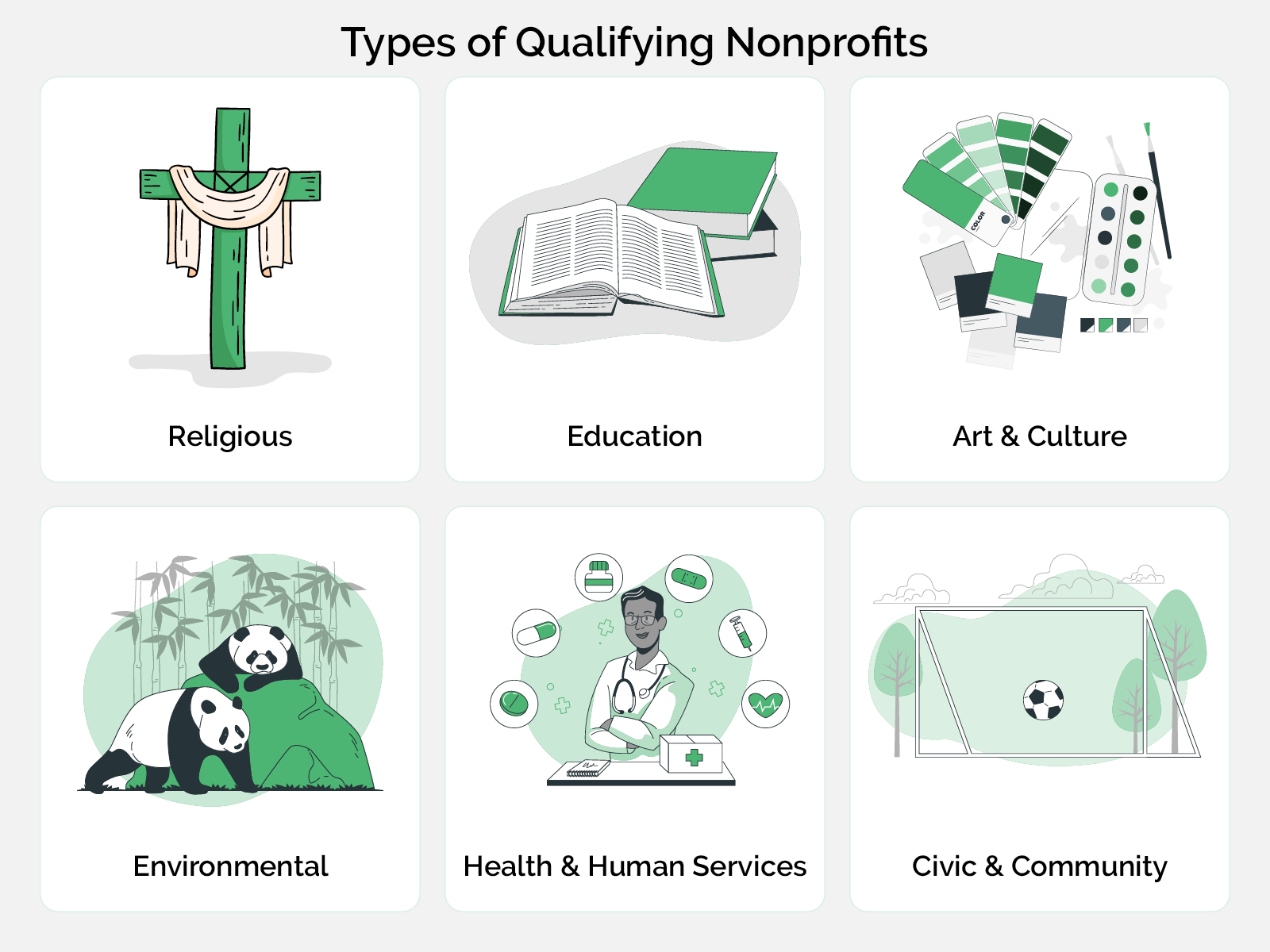
- Most 501(c)(3) nonprofits and foundations, excluding political or religious causes
- Religiously affiliated organizations that serve secular purposes for the greater community, such as soup kitchens, homeless shelters, food banks, or schools
- Educational institutions like K-12 schools, colleges, and universities
- Arts and cultural organizations, including museums, performing arts centers, and historical societies
- Environmental groups that oversee animal protection services and conservation programs
- Health organizations leading disease research and treatment
However, some companies may opt to venture into matching gifts gradually with a custom matching gift program. If you go this route, your leadership would select a particular nonprofit to support and encourage team members to get involved. Employees would then make their personal donations, typically within a limited time frame, and your company ultimately matches the total contributed at a pre-determined rate.
*While 360MatchPro offers custom matching gift program management functionality, this feature is designed specifically for fundraisers looking to manage custom matching gift initiatives—360MatchPro does not work directly with corporations. If you’re a company interested in starting a matching gift program, contact us, and we’ll share information about our corporate vendor partners.
Meanwhile, eligible team members are generally categorized by the following employment types:
- Current full-time
- Current part-time
- Retirees
- Board members
- Executives
- Employee spouses
You might even decide that different nonprofit mission types and employees may qualify for different matching gift levels. For example, some companies set elevated match maximums for education institutions and lower thresholds for other 501(c)(3) organizations. Alternatively, businesses may match executive or board member donations at a higher ratio (such as 2:1 or 3:1), while other staff qualify for a standard 1:1 match.
Set a match request deadline.
A match deadline is the date by which employees must submit matching gift requests to remain eligible for the program.
There are a few common deadline structures when it comes to corporate matching gifts. These include:
A set number of days, weeks, or months following an initial donation being made.
The end of the calendar year in which the initial donation was made.
The end of the calendar year in which the donation was made, plus a grace period of a few months.
Companies usually set additional stipulations that team members must be gainfully employed by the business at the time of the donation and the time of the request. However, remember that the more flexible the guidelines you set, the more likely employees are to complete the process.
2. Invest in Corporate Giving Software
After establishing matching gift guidelines, consider leveraging specialized technology to streamline and manage your philanthropic efforts. Take these steps to make a smart investment:
Decide if you need a CSR platform.
Determine whether your business needs to invest in software in the first place. While it’s possible to manage a matching gift program without automation, most companies opt to use a CSR platform to help scale and automate the matching gift process through innovative tech solutions.
As you’re exploring your options, consider asking yourself (and your team) the following questions:
- How many team members does my company currently employ? Do we have plans to expand soon?
- Does my team have the capacity to research, screen, and approve thousands of nonprofit causes?
- Do we have the bandwidth to review each match request submitted by an employee at your company?
- How do we provide a simple process for employees to request their matching gifts?
- Are we planning to launch any other corporate philanthropy programs in the near future, and if so, could we manage them with the same solution?
Overall, CSR software is a huge time saver that can go a long way toward strengthening the long-term value of your program. But if it’s not in the budget now (though there are cost-effective solutions for all types of businesses), you can always come back to these steps at a later date.
Review the top corporate giving technology providers.
If you’ve decided to invest in corporate giving software, now is the time to begin exploring your options. Luckily, you have a wide range of providers to choose from, so you’re sure to find one that best suits your needs.
As you compare and contrast top options, be sure to consider key factors, such as:
- Cost (including onboarding and regular fees)
- Support offerings
- Other giving programs available
- Client reviews and case studies
Some of the biggest names in the CSR technology industry include Benevity and YourCause. These software providers work with many of the most well-known matching gift companies, including Home Depot, Walt Disney Corporation, Microsoft, Google, and Apple.
However, we’ve also seen a significant influx of breakthrough matching gift software providers designed to aid smaller and mid-sized companies in managing their programs. This has made matching gifts more accessible to businesses of all shapes and sizes.
Prioritize auto-submission and other standout functionality.
Another factor to keep in mind when identifying prospective workplace-giving technology is innovation. Like any software provider, your matching gift solution must be able to keep up with the changing times. And the matching gift landscape is constantly evolving, too, making innovation a must-have priority.
One of the best examples here is the standout auto-submission functionality. Developed by Double the Donation in partnership with select future-focused CSR platforms, auto-submission is revolutionizing the matching gift process.
The overall goal of auto-submission is to simplify submissions through technology partnerships. This makes matching gifts easier for companies, their employees, and the organizations they each support. And in doing so, it increases staff participation in the programs, consequently driving team-wide engagement, productivity, longevity, brand image, and even profitability.
Here’s how it works:
- An individual donates to a nonprofit that uses the matching gift solution 360MatchPro by Double the Donation. During the donation process, they select their employer from a company search tool.
- After identifying that the donor works for a company with auto-submission enabled, they are provided with an easy way to complete their matching donation request directly from the organization’s confirmation screen. This typically involves entering their corporate email address and authorizing 360MatchPro to submit a match on their behalf.
- The 360MatchPro platform compiles match request information from the donation process and submits the data to the company’s corporate giving platform for streamlined review and approval.
Currently, this exclusive offering is made available by corporate giving providers Millie, POINT, Givinga, Selflessly, and more. So if auto-submission is a priority for your new matching gift program (which it should be in order to drive impact), we recommend looking at these top innovative solutions.
Double the Donation’s auto-submission functionality is available for all CSR vendors to build—and we expect more integrations to go live in the coming months. If you have a question about a particular solution or would like your CSR platform to build an integration with Double the Donation, let us know.
Consider Double the Donation’s standard matching gift form.
Though working with a dedicated corporate giving software vendor is our top recommendation, your company might not be ready to take the leap. In that case, Double the Donation offers a free Standard Matching Gift Form that companies can accept to streamline the submission process for employees.
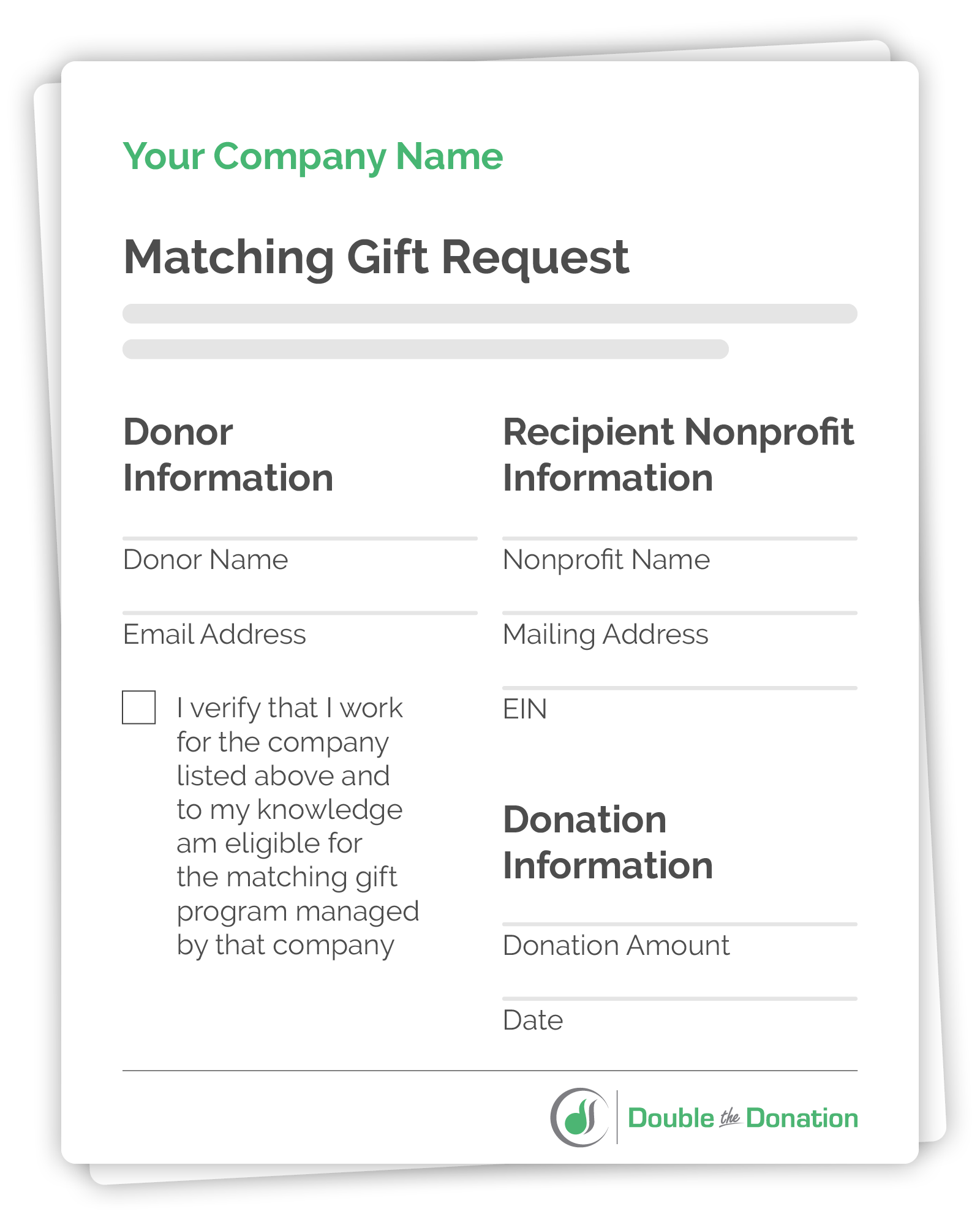
By noting that your company accepts our common form, you enable donors to auto-submit their matching gift requests from their favorite organizations’ websites with ease.
Once an individual verifies their identity and authorizes Double the Donation to complete the match on their behalf, the required information is collected and sent straight to your company’s match program coordinator in a pre-filled PDF format.
3. Promote Your Matching Gift Program
Now that your newly developed program is live, promote the initiative to your team and encourage them to get involved.
Here’s what we recommend you do to drive program impact and usage:
Add your new matching initiative to Double the Donation’s database.
Double the Donation hosts the industry’s most comprehensive and up-to-date database of corporate giving information. This resource contains program details for tens of thousands of companies that match gifts and aims to streamline the submission process for donors by providing easy access to the information they need.

If you want to make it easy on your employees, make sure you get your company’s new program added to the database! You can do so by filling out Double the Donation’s brief online form.
This page will ask for some basic information, such as:
- Company name
- Available programs (matching gifts and/or volunteer grants)
- Existing submission materials (as well as interest in developing a streamlined submission process such as our standard match form or working with a CSR vendor)
- Matching gift eligibility requirements (including minimum and maximum donation thresholds, types of qualifying employees and nonprofits)
- Corporate giving coordinator contact information (specific person or department)
Once your new program has been added to the database, your provided forms and guidelines will be made available to employees as they give to their favorite nonprofits. And if you’ve enabled auto-submission capabilities, individuals can submit their matches directly from their gift confirmation screens!
Inform employees about corporate giving opportunities.
There are also several things you can do to ensure your employees are aware of matching gift opportunities, which is essential for getting them to submit match requests. Adding your program to Double the Donation’s matching gift database is great. At the same time, promoting the initiative internally communicates that you’re serious about matching gifts.
Not only that, but employees love matching gift programs. In fact, research shows that individuals are 84% more likely to donate if they know a match is being offered. Plus, 1 in 3 stated they’d typically make a larger donation.
That’s why we recommend:
- Sending team-wide resources highlighting the impact of matching gifts;
- Providing easy access to the company’s matching gift guideline documents in your employee handbook or other internal materials;
- Highlighting matching gift offerings on your company’s website and other publicly visible assets (fun fact: 88% of people want to know about a company’s CSR efforts).
- Mentioning matching gifts in new team member onboarding processes going forward;
- Incorporating reminders of program opportunities in internal communications throughout the year.
Currently, more than 78% of people who qualify for matching gifts don’t know they’re eligible. Matching gift programs are a win-win-win situation, but no one can benefit unless your employees know about the opportunity.
Incentivize staff participation in workplace giving.
You can also increase donation matching rates by incentivizing participation in the program. Some of the best ways to do this include:
- Creating friendly competition. Pit team members or departments against one another to see who can get the most donations matched to qualifying organizations, and offer a prize to the winners.
- Establishing a sense of urgency. Set a specific giving objective and a deadline by which you’d like to achieve it. Then, offer a team-wide incentive for reaching the goal.
- Driving home the impact of matching gifts. One of the best parts about matching employee gifts is that you know they care about the organizations they’re supporting. Make sure to emphasize the doubled donation value offered to their favorite causes when they participate in matching.
In addition to these strategies, implement a recognition program to acknowledge and celebrate employees who actively participate in the matching gift program, whether through internal awards, public acknowledgments, or certificates of achievement.
A Final Note About Starting a Matching Gift Program
As you start your matching gift program, remember that its impact extends far beyond the financial contributions. Matching gifts will strengthen the bond between your company and its employees, promote a culture of giving, and reinforce the values of corporate social responsibility.
To learn more about corporate matching gifts, check out these additional resources:
- Matching Gift Auto-Submission + CSR Platforms | What to Know. Bring your matching gift efforts to the next level by enabling innovative auto-submission functionality. Doing so streamlines the process for you, your employees, and the nonprofits you support.
- What Is Workplace Giving For Companies & Why Does It Matter? Interested in expanding your company’s philanthropic efforts? Read up on the basics, key program offerings, and tips for getting started with impactful initiatives.
- Measuring the Impact of CSR: Top 4 Benefits for Businesses. Discover other top benefits of corporate social responsibility for businesses beyond standout marketing strategies. Plus, explore tried and true best practices for success.
